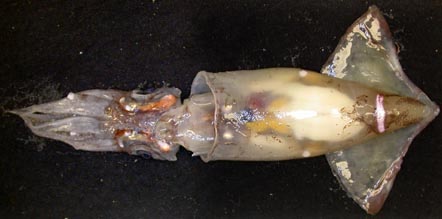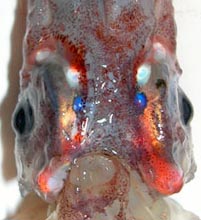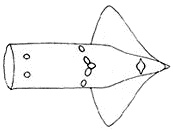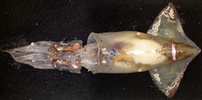Lycoteuthis lorigera
Michael Vecchione and Richard E. YoungIntroduction
Females of this species are, presently, are nearly indistinguishable from those of L. springeri, except for their heavier musculature and the single large photophore in a pocket in the musculature at the apex of the fins slightly dorsoposteriorly to the convex surface of the conus of the gladius in both sexes of L. springeri but absent in both sexes of L. lorigera.Characteristics
- Head
- Beaks: Descriptions can be found here: Lower beak; upper beak.
- Beaks: Descriptions can be found here: Lower beak; upper beak.
- Mantle
- Males lack elongate tail.
- Photophores
- Posterior abdominal photophores fused into single, broad organ in males.
- No large photophore in a pocket in the musculature of the apex of the fins
slightly dorsoposteriorly to the convex surface of the conus of the gladius in either sex.
Figure. Ventral view mantle of the mantel of L. lorigera showing arrangement of visceral photophores, male, holotype, 180 mm ML. Drawing from Voss (1962, p. 289).
Comments
Tentacular clubs and club and arm suckers have no known species-specific features.
Note the bright blue, mid-ventral ocular photophore on each eye in one of the title photographs. This blue photophore seems to be typical of members of the Lycoteuthinae. Also red integumental pigment covers (or partly covers due to damage) the other ocular photophores. This pigment would appear to be a color filter that would transmit blue light. Why two different means of producing blue light are needed is unknown
Distribution
The type locality is the "South Sea" in the Pacific Ocean. Distribution range extends between 23°S and 46°S in the South Atlantic and Indian Oceans (Villanueva and Sánchez, 1993).
A trawl that captured a single male off New Zealand also captured 104 females. The trawl was positioned 20-80 m off the bottom in 500 m of water (Försch and Uozumi, 1990).
References
Förch, E. C. and Y. Uozumi. 1990. Discovery of a specimen fo Lycoteuthis lorigera (Steenstrup, 1875) (Cephalopoda: Teuthoidea) from New Zealand and additional notes on its morphology. New Zealand Jour. Mar. Freshw. Res., 24: 251-258.
Toll, R. B. 1983. The lycoteuthid genus Oregoniateuthis Voss, 1956, a synonym of Lycoteuthis Pfeffer, 1900 (Cephalopoda: Teuthoidea). Proc. Biol. Soc. Wash. 96: 365-369.
Villanueva, R. and P. Sanchez. 1993. Cephalopods of the Benguela Current off Namibia: new additions and considerations on the genus Lycoteuthis. Journal of Natural History, 27:15-46.
Voss, G. L. 1962. A monograph of the Cephalopoda of the North Atlantic. I. The Family Lycoteuthidae. Bull. Mar. Sci. Gulf Carib. 12: 264-305.
Title Illustrations

| Scientific Name | Lycoteuthis lorigera |
|---|---|
| Location | South Pacific |
| Sex | Female |
| View | Ventral |
| Size | ca. 115 mm ML |
| Copyright | © 2005 Mark Norman |
| Scientific Name | Lycoteuthis lorigera |
|---|---|
| Comments | Same specimen |
| Sex | Female |
| View | Ventral |
| Size | ca. 115 mm ML |
| Copyright | © 2005 Mark Norman |
| Scientific Name | Lycoteuthis lorigera |
|---|---|
| Location | Sub-Antarctic waters near New Zealand at 51°58'S, 171°40'E |
| Comments | Caught in bottom trawl at 520 m. |
| Acknowledgements | National Institute of Water & Atmospheric Research (NIWA) |
| Specimen Condition | Fresh |
| Identified By | Darren Stevens |
| Sex | Male |
| View | Ventral |
| Collector | NIWA |
| Image Use |
 This media file is licensed under the Creative Commons Attribution License - Version 3.0. This media file is licensed under the Creative Commons Attribution License - Version 3.0.
|
| Copyright | © |
About This Page
Figure from Voss, 1962 printed with the Permission of the Bulletin of Marine Science.

National Museum of Natural History, Washington, D. C. , USA

University of Hawaii, Honolulu, HI, USA
Page copyright © 2015 and
 Page: Tree of Life
Lycoteuthis lorigera .
Authored by
Michael Vecchione and Richard E. Young.
The TEXT of this page is licensed under the
Creative Commons Attribution-NonCommercial License - Version 3.0. Note that images and other media
featured on this page are each governed by their own license, and they may or may not be available
for reuse. Click on an image or a media link to access the media data window, which provides the
relevant licensing information. For the general terms and conditions of ToL material reuse and
redistribution, please see the Tree of Life Copyright
Policies.
Page: Tree of Life
Lycoteuthis lorigera .
Authored by
Michael Vecchione and Richard E. Young.
The TEXT of this page is licensed under the
Creative Commons Attribution-NonCommercial License - Version 3.0. Note that images and other media
featured on this page are each governed by their own license, and they may or may not be available
for reuse. Click on an image or a media link to access the media data window, which provides the
relevant licensing information. For the general terms and conditions of ToL material reuse and
redistribution, please see the Tree of Life Copyright
Policies.
- Content changed 11 October 2015
Citing this page:
Vecchione, Michael and Richard E. Young. 2015. Lycoteuthis lorigera . Version 11 October 2015. http://tolweb.org/Lycoteuthis_lorigera/19738/2015.10.11 in The Tree of Life Web Project, http://tolweb.org/














 Go to quick links
Go to quick search
Go to navigation for this section of the ToL site
Go to detailed links for the ToL site
Go to quick links
Go to quick search
Go to navigation for this section of the ToL site
Go to detailed links for the ToL site